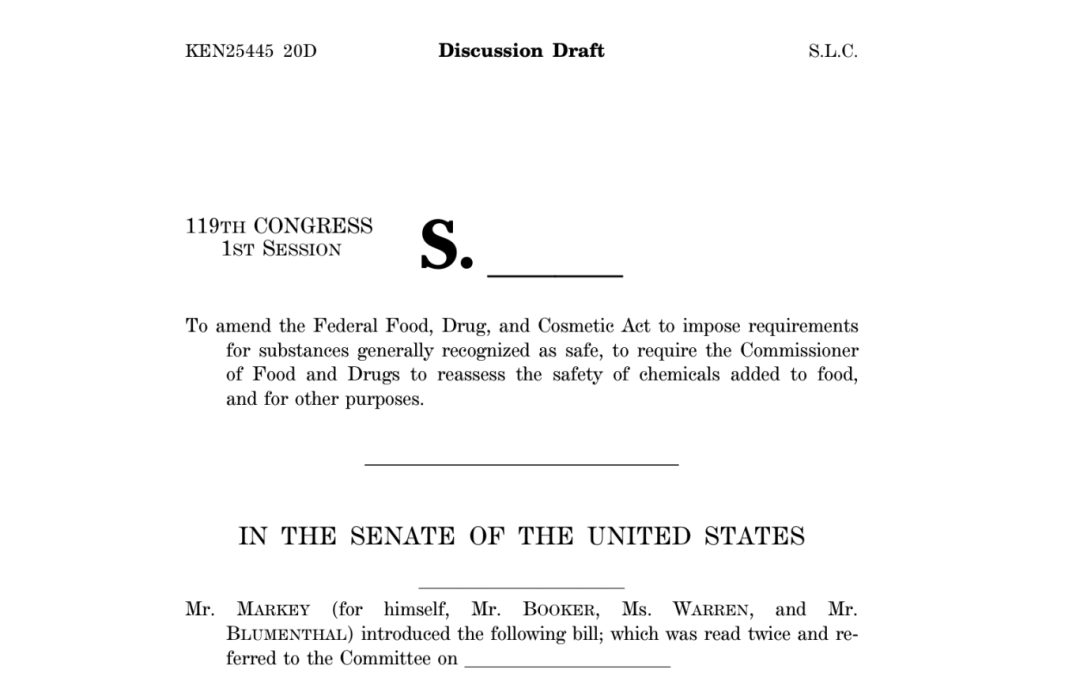Closing gras "loophole": New Bill Proposes to Strengthen FDA's Regulation of Food Chemicals in the U.S.
Recently, new legislation aiming to reform the U.S. Food and Drug Administration’s (FDA) Generally Recognized as Safe (GRAS) rules has been submitted to Congress. The 2025 Ensuring Safe and Toxic-Free Foods Act was introduced by Senators Ed Markey and Cory Booker. The bill aims to address regulatory gaps in the GRAS rules for food additives and food contact materials through more stringent safety reviews and transparency requirements.

Source: markey.senate.gov
The GRAS (Generally Recognized as Safe) rule was established by the FDA in 1972 to allow food ingredients that are widely recognized as safe (such as vinegar) to continue being used without review. Substances evaluated as GRAS can not only be used in food processing but may also be used in food contact materials under certain conditions.
However, critics have pointed out that certain loopholes in the GRAS rule may allow novel additives to enter the food supply without adequate safety assessment. The new bill does not recognize substances previously determined as GRAS through self-affirmation, and in effect, seeks to require all GRAS substances to be reviewed and approved by the FDA. The senators also hope to strengthen the rigor of the FDA’s GRAS review process through this bill, in response to the public’s growing concerns about food safety.
The "2025 Safe and Non-toxic Food Act" proposes the following key reforms:
Stricter GRAS determination requirements: manufacturers must submit toxicological data, exposure analysis, and evidence proving that the substance is neither carcinogenic nor reproductive toxic.
Enhance transparency: The FDA should disclose GRAS notifications and provide a 60-day public comment period.
The FDA's authority: The FDA can reject previous GRAS determinations due to incomplete documentation, conflicts of interest among relevant experts, or insufficient evidence, and can reassess and revoke GRAS status at any time.
Exclude high-risk substances: Prohibit untested or known toxic substances from obtaining GRAS status.
Annual Review Quota: The FDA must review at least 50 GRAS notifications each year until the backlog is cleared.
Expert Panel Reform: The FDA will update guidelines to ensure the independence and transparency of GRAS expert panels.
In addition, the bill requires the FDA to reassess at least 10 food chemicals or categories every three years, prioritizing substances of public or regulatory concern, and manufacturers are required to provide relevant data. The strict scientific standards for GRAS determination will also apply to these reassessments.
If enacted, the “Ensuring Safe and Non-toxic Foods Act of 2025” will significantly enhance regulatory requirements for GRAS Notices concerning food additives and food contact materials. By mandating the submission of scientific evidence, instituting a 60-day public comment period, and granting the FDA authority to reject or reevaluate submissions, the Act will greatly improve the rigor and transparency of the review process.
For companies that have already obtained GRAS authorization, it is important to be aware that existing substances may be subject to re-evaluation, especially those that have attracted public attention.
Enterprises intending to apply for GRAS authorization should prepare detailed toxicological data, exposure analysis, and safety evidence in advance, avoid using untested or high-risk substances, and closely monitor the legislative progress related to GRAS.
The new regulations will drive the food industry towards a safer and more transparent direction, while also requiring companies to invest more resources in research and compliance to maintain market competitiveness and earn consumer trust.
【Copyright and Disclaimer】The above information is collected and organized by PlastMatch. The copyright belongs to the original author. This article is reprinted for the purpose of providing more information, and it does not imply that PlastMatch endorses the views expressed in the article or guarantees its accuracy. If there are any errors in the source attribution or if your legitimate rights have been infringed, please contact us, and we will promptly correct or remove the content. If other media, websites, or individuals use the aforementioned content, they must clearly indicate the original source and origin of the work and assume legal responsibility on their own.
Most Popular
-

List Released! Mexico Announces 50% Tariff On 1,371 China Product Categories
-

Nissan Cuts Production of New Leaf EV in Half Due to Battery Shortage
-

New Breakthrough in Domestic Adiponitrile! Observing the Rise of China's Nylon Industry Chain from Tianchen Qixiang's Production
-

Dow, Wanhua, Huntsman Intensively Raise Prices! Who Controls the Global MDI Prices?
-

Mexico officially imposes tariffs on 1,400 chinese products, with rates up to 50%






